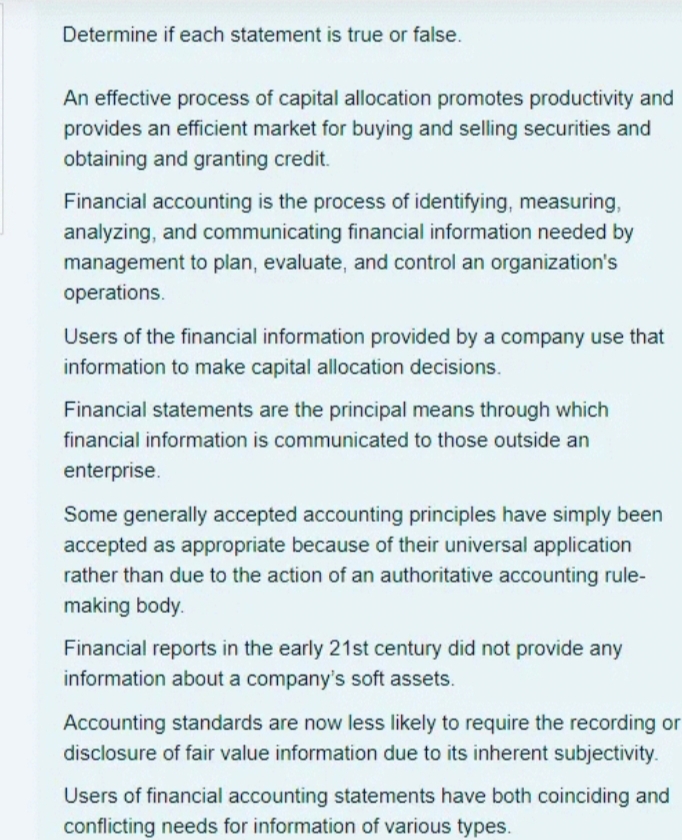An effective process of capital allocation promotes productivity and provides an efficient market for buying and selling securities and obtaining and granting credit.
An effective process of capital allocation promotes productivity and provides an efficient market for buying and selling securities and obtaining and granting credit.
Intermediate Accounting: Reporting And Analysis
3rd Edition
ISBN:9781337788281
Author:James M. Wahlen, Jefferson P. Jones, Donald Pagach
Publisher:James M. Wahlen, Jefferson P. Jones, Donald Pagach
Chapter2: Financial Reporting: Its Conceptual Framework
Section: Chapter Questions
Problem 4C
Related questions
Question
True or false

Transcribed Image Text:Determine if each statement is true or false.
An effective process of capital allocation promotes productivity and
provides an efficient market for buying and selling securities and
obtaining and granting credit.
Financial accounting is the process of identifying, measuring,
analyzing, and communicating financial information needed by
management to plan, evaluate, and control an organization's
operations.
Users of the financial information provided by a company use that
information to make capital allocation decisions.
Financial statements are the principal means through which
financial information is communicated to those outside an
enterprise.
Some generally accepted accounting principles have simply been
accepted as appropriate because of their universal application
rather than due to the action of an authoritative accounting rule-
making body.
Financial reports in the early 21st century did not provide any
information about a company's soft assets.
Accounting standards are now less likely to require the recording or
disclosure of fair value information due to its inherent subjectivity.
Users of financial accounting statements have both coinciding and
conflicting needs for information of various types.
Expert Solution
This question has been solved!
Explore an expertly crafted, step-by-step solution for a thorough understanding of key concepts.
This is a popular solution!
Trending now
This is a popular solution!
Step by step
Solved in 2 steps

Recommended textbooks for you

Intermediate Accounting: Reporting And Analysis
Accounting
ISBN:
9781337788281
Author:
James M. Wahlen, Jefferson P. Jones, Donald Pagach
Publisher:
Cengage Learning

Cornerstones of Financial Accounting
Accounting
ISBN:
9781337690881
Author:
Jay Rich, Jeff Jones
Publisher:
Cengage Learning

Financial Reporting, Financial Statement Analysis…
Finance
ISBN:
9781285190907
Author:
James M. Wahlen, Stephen P. Baginski, Mark Bradshaw
Publisher:
Cengage Learning

Intermediate Accounting: Reporting And Analysis
Accounting
ISBN:
9781337788281
Author:
James M. Wahlen, Jefferson P. Jones, Donald Pagach
Publisher:
Cengage Learning

Cornerstones of Financial Accounting
Accounting
ISBN:
9781337690881
Author:
Jay Rich, Jeff Jones
Publisher:
Cengage Learning

Financial Reporting, Financial Statement Analysis…
Finance
ISBN:
9781285190907
Author:
James M. Wahlen, Stephen P. Baginski, Mark Bradshaw
Publisher:
Cengage Learning

Principles of Accounting Volume 2
Accounting
ISBN:
9781947172609
Author:
OpenStax
Publisher:
OpenStax College

Intermediate Financial Management (MindTap Course…
Finance
ISBN:
9781337395083
Author:
Eugene F. Brigham, Phillip R. Daves
Publisher:
Cengage Learning